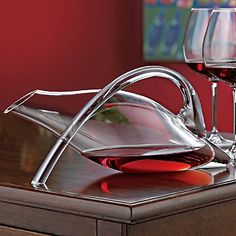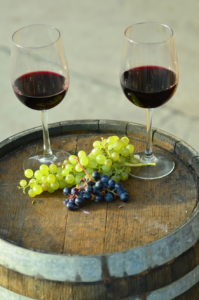Why Decant Your Wine?

We all need to take a breather once in a while, and great wine is no different.
Wine has a life and breadth to it that, sometimes, needs to expand to allow the full strength of the wine to be enjoyed. As it is exposed to the air, some of its components are changed. There are some wines that should be aerated, also known as decanting, while others should be poured from the bottle with as little contact to the air as possible.
One rule of thumb is most red wines are great at being decanted. While this is not the case with Zinfandel or Pinot Noir, it is great for red wines that are younger, bigger, and more tannic. Why you may ask? Well, to decant, or breathe, the wine, allows them to age a little more. You may want to try it with our Merlot or Nui Awa.
As you are learning about the wonders of decanting, you may be thinking how can this simple step create such a difference? Well, there are two reasons that decanting works. First is the aesthetics. Wine, as it matures, will form sediments that can “muddy” the wine. This sediment has the power to deaden the flavor and its expression. Even with the filtration systems that have been in use for years now, there is always the creation of sediments. 
There are a few reasons why you would want to decant. One reasoning is presentation. Depending on the type and age of the wine, its sediments can cloud the liquid, making the overall presentation not as appealing. Another reason is to enhance the flavor through aeration. Some wines, mostly reds, can have gasses that have been trapped in the bottle due to a lack of oxygen. By introducing oxygen back into the wine, the gasses are released, which allows a more clear taste to expand. The third reason is a broken cork! Sometimes, a cork is broken while the bottle is opened, which will lead to small objects floating in the wine. Not something to look forward to! In this instance, I would recommend using a wine strainer, to make sure that none of the small pieces of cork will pass into the bottle.
If you decide to decant due to sediments, there might be a few steps that need to be followed before you enjoy your wonderful wine. If you have your wine stored horizontally, you will need to let it sit vertically for a few days to allow the sediments to fall to the bottom of the bottle. You will also need to be sure that the wine has not moved for a few days prior to opening, due to the disruption of the solids, especially in older wines.
When you are ready to decant, make sure that the wine is moved slowly with little jostling. As you are pouring, have the neck touch the shoulder of the decanter. Pour slowly at a 45-degree angle and stop as soon as you see the sediment leave the bottle. This way, there will be the least amount of sediment in the wine that you will enjoy. If clarity was your only goal, then you’re on your way to the perfect glass If you are trying to aerate the wine, then there are some more steps.
“Do not fear the smell of rotten eggs!” This smell is created by hydrogen sulfide, which is one of the main components of wine that makes wine not as breathable. It should take 30-60 minutes for the compounds to diffuse completely. This specific compound is very common in red wines that have “been produced under hermetic conditions and sealed with very tight closures.” Therefore, the decanting step is very important.
Once you decant a wine, you shouldn’t put it back into the bottle. After some time, usually a few days, the aeration process will continue and will lead to diffusing most of the components, leaving the wine to be obsolete. …I know I know, obsolete wine? Alas, it does happen.
Many red wines can be enhanced through decanting, but there are only a few white wines that can use this step. Only Chardonnays and Burgundy white wines can really be enhanced. It should only take around 30 minutes for the wine to fully breathe. You will know when the wine is ready when their secondary aromas leave. These smells are rotten vegetation, a struck match, or an asparagus smell. Make sure not to decant these wines close to your guests, or they might be a little confused about what’s on the stove. Most white wines will not have these scents, which leads to them not needing to have this step.
Another reason to decant your wines is presentation. Many decanters are a work of art. There are different types of decanters for different wines and each one is more beautiful than the last.
There are seven main types of decanters. Swan, Cornett, Duck, Standard, Small, Medium, and Large. Each one has a different strength. Those with a wide base are best for full-bodied reds, such as Cabernet Sauvignon. The medium-sized decanters are best for medium-bodied reds, like Merlot, while the small and medium-sized decanters are best for light-bodied, such as Pinot Noir. When you want to open a white or rose wine, a small decanter that has been chilled is a wonderful choice.
Even though this feels like an elaborate science class, you will be able to enjoy your wine even more. Check out this article for the decanting time of each type of red wine.


